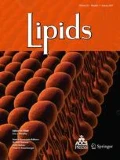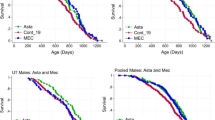Abstract
Reactive oxygen species react with unsaturated fatty acids to form a variety of metabolites including aldehydes. Many aldehydes are volatile enough to be detected in headspace gases of blood or cultured cells and in exhaled breath, in particular propanal and hexanal which are derived from omega-3 and omega-6 polyunsaturated fatty acids, respectively. Aldehydes are therefore potential non-invasive biomarkers of oxidative stress and of various diseases in which oxidative stress is thought to play a role including cancer, cardiovascular disease and diabetes. It is unclear, however, how changes in the abundance of the fatty acid precursors, for example by altered dietary intake, affect aldehyde concentrations. We therefore fed male Wistar rats diets supplemented with either palm oil or a combination of palm oil plus an n-3 fatty acid (alpha-linolenic, eicosapentaenoic, or docosahexaenoic acids) for 4 weeks. Fatty acid analysis revealed large changes in the abundance of both n-3 and n-6 fatty acids in the liver with smaller changes observed in the brain. Despite the altered fatty acid abundance, headspace concentrations of C1–C8 aldehydes, and tissue concentrations of thiobarbituric acid reactive substances, did not differ between the 4 dietary groups. Our data suggest that tissue aldehyde concentrations are independent of fatty acid abundance, and further support their use as volatile biomarkers of oxidative stress.
Similar content being viewed by others
Abbreviations
- ALA:
-
Alpha-linolenic acid
- ANOVA:
-
Analysis of variance
- DHA:
-
Docasahexaenoic acid
- EPA:
-
Eicosapentaenoic acid
- ID:
-
Internal diameter
- MDA:
-
Malondialdehyde
- OD:
-
Outer diameter
- PUFA:
-
Polyunsaturated fatty acid
- PPBV:
-
Parts per billion by volume
- ROS:
-
Reactive oxygen species
- TBARS:
-
Thiobarbituric acid reactive substances
- VOC:
-
Volatile organic compounds
References
Španěl P, Smith D (2011) Progress in SIFT-MS: breath analysis and other applications. Mass Spectrom Rev 30:236–267
Halliwell B (1999) Free radicals in biology and medicine, 3rd edn. Oxford University Press, Oxford
Lawless MW, O’Byrne KJ, Gray SG (2010) Targeting oxidative stress in cancer. Expert Opin Ther Targets 14:1225–1245
Rains JL, Jain SK (2011) Oxidative stress, insulin signaling, and diabetes. Free Radic Biol Med 50:567–575
Cantor EJ, Mancini EV, Seth R, Yao XH, Netticadan T (2003) Oxidative stress and heart disease: cardiac dysfunction, nutrition, and gene therapy. Curr Hypertens Res 5:215–220
Xiao S, Zhang WG, Lee EJ, Ma CW, Ahn DU (2011) Effects of diet, packaging, and irradiation on protein oxidation, lipid oxidation, and color of raw broiler thigh meat during refrigerated storage. Poult Sci 90:1348–1357
Shahidi F (2001) Headspace volatile aldehydes as indicators of lipid oxidation in foods. Adv Exp Med Biol 488:113–123
Ross BM, Puukila S, Malik I, Babay S, Lecours M, Agostino A, Khaper N (2013) The use of SIFT-MS to investigate headspace aldehydes as markers of lipid peroxidation. Curr Anal Chem 9:600–613
Spaněl P, Smith D (2008) Quantification of trace levels of the potential cancer biomarkers formaldehyde, acetaldehyde and propanol in breath by SIFT-MS. J Breath Res 2:046003
Maclean R, Ward PE, Glen I, Roberts SJ, Ross BM (2003) On the relationship between methylnicotinate-induced skin flush and fatty acids levels in acute psychosis. Prog Neuropsychopharmacol Biol Psych 27:927–933
Bligh EG, Dyer WJ (1959) A rapid method of total lipid extraction and purification. Can J Biochem Physiol 37:911–917
Cayman Chemical Company (2011) TBARS assay kit. Retrieved from www.caymanchem.com/app/template/Product.vm/catalog/100009055
Španěl P, Dyahina K, Smith D (2006) A general method for the calculation of absolute trace gas concentrations in air and breath from selected ion flow tube mass spectrometry data. Int J Mass Spectrom 249(250):230–239
Arterburn LM, Hall EB, Oken H (2006) Distribution, interconversion, and dose response of n-3 fatty acids in humans. Am J Clin Nutr 83:S1467–S1476
Egert S, Kannenberg F, Somoza V, Erbersdobler HF, Wahrburg U (2009) Dietary α-linolenic acid, EPA, and DHA have differential effects on LDL fatty acid composition but similar effects on serum lipid profiles in normolipidemic humans. J Nutr 139:861–868
Valenzuela A, Von Bernhardi R, Valenzuela V, Ramírez G, Alarcón R, Sanhueza J, Nieto S (2003) Supplementation of female rats with alpha-linolenic acid or docosahexaenoic acid leads to the same omega-6/omega-3 LC-PUFA accretion in mother tissues and in fetal and newborn brains. Ann Nutr Metab 48:28–35
Kidd PM (2007) Omega-3 DHA and EPA for cognition, behavior, and mood: clinical findings and structural–functional synergies with cell membrane phospholipids. Altern Med Rev 12:207–227
Barceló-Coblijn G, Murphy EJ, Othman R, Moghadasian MH, Kashour T, Friel JK (2008) Flaxseed oil and fish-oil capsule consumption alters human red blood cell n-3 fatty acid composition: a multiple-dosing trial comparing 2 sources of n-3 fatty acid. Am J Clin Nutr 88:801–809
Caughey GE, Mantzioris E, Gibson RA, Cleland LG, James MJ (1996) The effect on human tumor necrosis factor alpha and interleukin 1 beta production of diets enriched in n-3 fatty acids from vegetable oil or fish oil. Am J Clin Nutr 63:116–122
Shindou H, Hishikawa D, Harayama T, Yuki K, Shimizu T (2009) Recent progress on acyl CoA: lysophospholipid acyltransferase research. J Lipid Res 50(Supplement):S46–S51
Stark AH, Crawford MA, Reifen R (2008) Update on alpha-linolenic acid. Nutr Rev 66:326–332
Harper CR, Edwards MJ, DeFilippis AP, Jacobson TA (2005) Flaxseed oil increases the plasma concentrations of cardioprotective (n-3) fatty acids in humans. J Nutr 136:83–87
Von Schacky C, Weber PC (1985) Metabolism and effects on platelet function of the purified eicosapentaenoic and docosahexaenoic acids in humans. J Clin Invest 76:2446–2450
Kaur G, Begg DP, Barr D, Garg M, Cameron-Smith D, Sinclair AJ (2010) Short-term docosapentaenoic acid (22: 5 n-3) supplementation increases tissue docosapentaenoic acid, DHA and EPA concentrations in rats. Br J Nutr 103:32–37
Goustard-Langelier B, Guesnet P, Durand G, Antoine JM, Alessandri JM (1999) n-3 and n-6 fatty acid enrichment by dietary fish oil and phospholipid sources in brain cortical areas and nonneural tissues of formula-fed piglets. Lipids 34:5–16
Neuringer M, Anderson GJ, Connor WE (1988) The essentiality of n-3 fatty acids for the development and function of the retina and brain. Ann Rev Nutr 8:517–541
Salem N Jr, Moriguchi T, Greiner RS, McBride K, Ahmad A, Catalan JN, Slotnick B (2001) Alterations in brain function after loss of docosahexaenoate due to dietary restriction of n-3 fatty acids. J Mol Neurosci 16:299–307
Engström K, Saldeen AS, Yang B, Mehta JL, Saldeen T (2009) Effect of fish oils containing different amounts of EPA, DHA, and antioxidants on plasma and brain fatty acids and brain nitric oxide synthase activity in rats. Ups J Med Sci 114:206–213
Chen CT, Liu Z, Bazinet RP (2011) Rapid de-esterification and loss of eicosapentaenoic acid from rat brain phospholipids: an intracerebroventricular study. J Neurochem 116:363–373
Ross BM, Glen I (2014) Breath ethane concentrations in healthy volunteers correlate with a systemic marker of lipid peroxidation but not with omega-3 fatty acid availability. Metabolites 4:572–579
Rhodes LE, O’Farrell S, Jackson MJ, Friedmann PS (1994) Dietary fish-oil supplementation in humans reduces UVB-erythemal sensitivity but increases epidermal lipid peroxidation. J Invest Dermatol 103:151–154
Nenseter MS, Drevon CA (1996) Dietary polyunsaturates and peroxidation of low density lipoprotein. Curr Opin Lipidol 7:8–13
Mori TA (2004) Effect of fish and fish oil-derived omega-3 fatty acids on lipid oxidation. Redox Rep 9:193–197
Iraz M, Erdogan H, Ozyurt B, Ozugurlu F, Ozgocmen S, Fadillioglu E (2005) Omega-3 essential fatty acid supplementation and erythrocyte oxidant/antioxidant status in rats. Ann Clin Lab Sci 35:169–173
Barbosa DS, Cecchini R, El Kadri MZ, Rodriguez MA, Burini RC, Dichi I (2003) Decreased oxidative stress in patients with ulcerative colitis supplemented with fish oil omega-3 fatty acids. Nutrition 19:837–842
Wu A, Ying Z, Gomez-Pinilla F (2004) Dietary omega-3 fatty acids normalize BDNF levels, reduce oxidative damage, and counteract learning disability after traumatic brain injury in rats. J Neurotrauma 21:1457–1467
Španěl P, Van Doren JM, Smith D (2002) A selected ion flow tube study of the reactions of H3O+, NO+ and O +·2 with saturated and unsaturated aldehydes and subsequent hydration of the product ions. Int J Mass Spectrom 213:163–176
Španěl P, Ji Y, Smith D (1997) SIFT studies of the reactions of H3O+, NO+ and O +·2 with a series of aldehydes and ketones. Int J Mass Spectrom Ion Process 165(166):25–37
Smith D, Chippendale TWE, Španěl P (2014) Reactions of the selected ion flow tube mass spectrometry reagent ions H3O+ and NO+ with a series of volatile aldehydes of biogenic significance. Rapid Commun Mass Spectrom 28:1917–1928
Acknowledgments
This study was financially supported by the Canadian National Science and Engineering Research Council.
Author information
Authors and Affiliations
Corresponding author
About this article
Cite this article
Ross, B.M., Babay, S. & Malik, I. Brain and Liver Headspace Aldehyde Concentration Following Dietary Supplementation with n-3 Polyunsaturated Fatty Acids. Lipids 50, 1123–1131 (2015). https://doi.org/10.1007/s11745-015-4063-3
Received:
Accepted:
Published:
Issue Date:
DOI: https://doi.org/10.1007/s11745-015-4063-3




